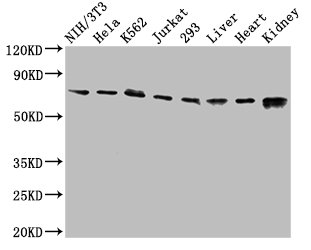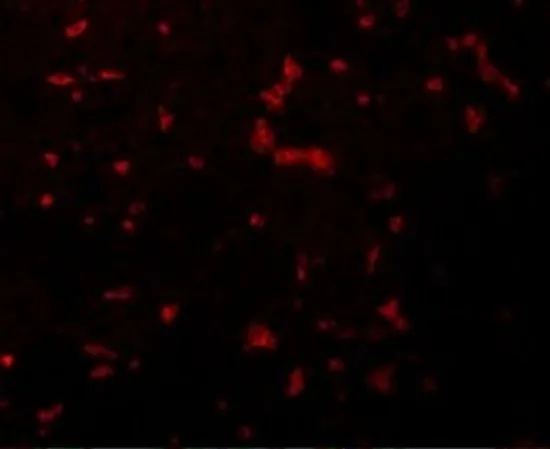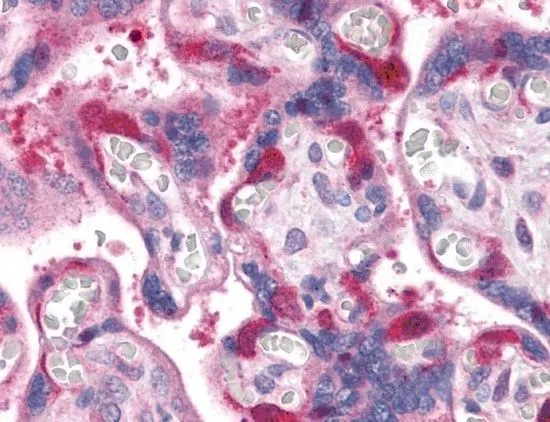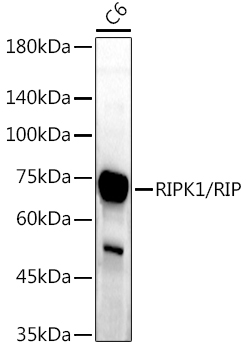RIP antibody
GTX111074
ApplicationsImmunoFluorescence, Western Blot, ImmunoCytoChemistry
Product group Antibodies
TargetRIPK1
Overview
- SupplierGeneTex
- Product NameRIP antibody
- Delivery Days Customer9
- Application Supplier NoteWB: 1:1000-1:10000. ICC/IF: 1:100-1:1000. *Optimal dilutions/concentrations should be determined by the researcher.Not tested in other applications.
- ApplicationsImmunoFluorescence, Western Blot, ImmunoCytoChemistry
- CertificationResearch Use Only
- ClonalityPolyclonal
- Concentration1 mg/ml
- ConjugateUnconjugated
- Gene ID8737
- Target nameRIPK1
- Target descriptionreceptor interacting serine/threonine kinase 1
- Target synonymsAIEFL, IMD57, RIP, RIP-1, RIP1, receptor-interacting serine/threonine-protein kinase 1, cell death protein RIP, receptor (TNFRSF)-interacting serine-threonine kinase 1, receptor-interacting protein 1, receptor-interacting protein kinase 1, serine/threonine-protein kinase RIP
- HostRabbit
- IsotypeIgG
- Protein IDQ13546
- Protein NameReceptor-interacting serine/threonine-protein kinase 1
- Scientific DescriptionEssential adapter molecule for the activation of NF-kappa-B. Following different upstream signals (binding of inflammatory cytokines, stimulation of pathogen recognition receptors, or DNA damage), particular RIPK1-containing complexes are formed, initiating a limited number of cellular responses. Upon TNFA stimulation RIPK1 is recruited to a TRADD-TRAF complex initiated by TNFR1 trimerization. There, it is ubiquitinated via Lys-63-link chains, inducing its association with the IKK complex, and its activation through NEMO binding of polyubiquitin chains.
- Storage Instruction-20°C or -80°C,2°C to 8°C
- UNSPSC12352203
References
- Lanzillotta C, Zuliani I, Tramutola A, et al. Chronic PERK induction promotes Alzheimer-like neuropathology in Down syndrome: Insights for therapeutic intervention. Prog Neurobiol. 2021,196:101892. doi: 10.1016/j.pneurobio.2020.101892Read this paper
- Chen YH, Chen YC, Lin CC, et al. Synergistic Anticancer Effects of Gemcitabine with Pitavastatin on Pancreatic Cancer Cell Line MIA PaCa-2 in vitro and in vivo. Cancer Manag Res. 2020,12:4645-4665. doi: 10.2147/CMAR.S247876Read this paper
- Saemisch M, Balcells M, Riesinger L, et al. Subendothelial matrix components influence endothelial cell apoptosis in vitro. Am J Physiol Cell Physiol. 2019,316(2):C210-C222. doi: 10.1152/ajpcell.00005.2018Read this paper
- Saemisch M, Nickmann M, Riesinger L, et al. 3D matrix-embedding inhibits cycloheximide-mediated sensitization to TNF-alpha-induced apoptosis of human endothelial cells. J Tissue Eng Regen Med. 2018,12(4):1085-1096. doi: 10.1002/term.2609Read this paper
- Tsui KH, Wang PH, Lin LT, et al. DHEA protects mitochondria against dual modes of apoptosis and necroptosis in human granulosa HO23 cells. Reproduction. 2017,154(2):101-110. doi: 10.1530/REP-17-0016Read this paper
- Lin CY, Chang TW, Hsieh WH, et al. Simultaneous induction of apoptosis and necroptosis by Tanshinone IIA in human hepatocellular carcinoma HepG2 cells. Cell Death Discov. 2016,2:16065.Read this paper
- Li CJ, Sun LY, Pang CY. Synergistic protection of N-acetylcysteine and ascorbic acid 2-phosphate on human mesenchymal stem cells against mitoptosis, necroptosis and apoptosis. Sci Rep. 2015,5:9819. doi: 10.1038/srep09819Read this paper




